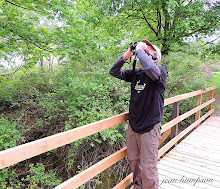Being birders, Jean and I have a small number of bird prints (though growing) adorning the walls of our home (either received as gifts or purchased by ourselves). Even before we started to obsessively keep a life list we had three prints lining the wall along the stairs to the second floor, a fourth we purchased at the Magnolia Plantation in South Carolina now keeps them company.
For my birthday last year, Jean gave me a most excellent gift, the complete set (24 prints) of Fenwick Lansdowne's Birds of Canada (1959), presented by the Star Weekly. A coworker of Jean's brought the set in for Jean to look over before taking them to her church's rummage sale.
The 14 x 10.5" prints were still in the original envelope, postmarked with a prodigious postage of 7 cents! Without hesitation Jean purchased them on the spot.
We purchased two frames and the first print selected for a wall in the spare room was the Hermit Thrush. The second frame remained empty until the return from our vacation in British Columbia in June of this year. In honour of the lifer observed at Lake Louise, the Clark's Nutcracker print hangs at the top of the stairs. Every morning, I am greeted by Lansdowne's rendition of the gray and black bird as I walk down the hallway.

Accompanying each print in this series is text written by Hugh M Halliday. He has written a few books on the Canadian wildlife he encountered while travelling this vast country.
Clark's Nutcracker was named after Capt. William Clark of the famed Lewis and Clark exploratory expedition which crossed the continent in 1884-86. He was first to report the species. In Canada it inhabits the mountainous regions of British Columbia and Alberta. It is also called Clark's crow and has much in common with that other member of the crow family, the Canada jay, known also as whiskey jack, camp robber and other names. It comes into camp, is noisy and "talkative" and entertains with its antics. Nutcrackers often perform gymnastics. They "discuss" neighborhood topics. Favorite habitat of this distinguished bird is high on evergreen slopes of the western mountains. If protection is afforded, the nutcracker, white except for wings and tail, is likely to become so tame it will eat from a person's hand. It is fond of meat and can be found on hand for scraps from the picnic tables in western national parks. In winter its food is the seeds of conifers. It alights on a branch bearing a cluster of cones, jerks one loose with a foot and, swooping to the ground, picks up the cone in its bill and carries it away to tear it apart and get at the seeds. But being a crow it will eat almost anything.
Hugh M Halliday
Star Weekly, 1959
I don't expect to mount all the prints. Even I find it a bit excessive but I'm sure there is room for a couple more. Which ones will be selected is yet to be determined. It is quite the decision to make.







No comments:
Post a Comment